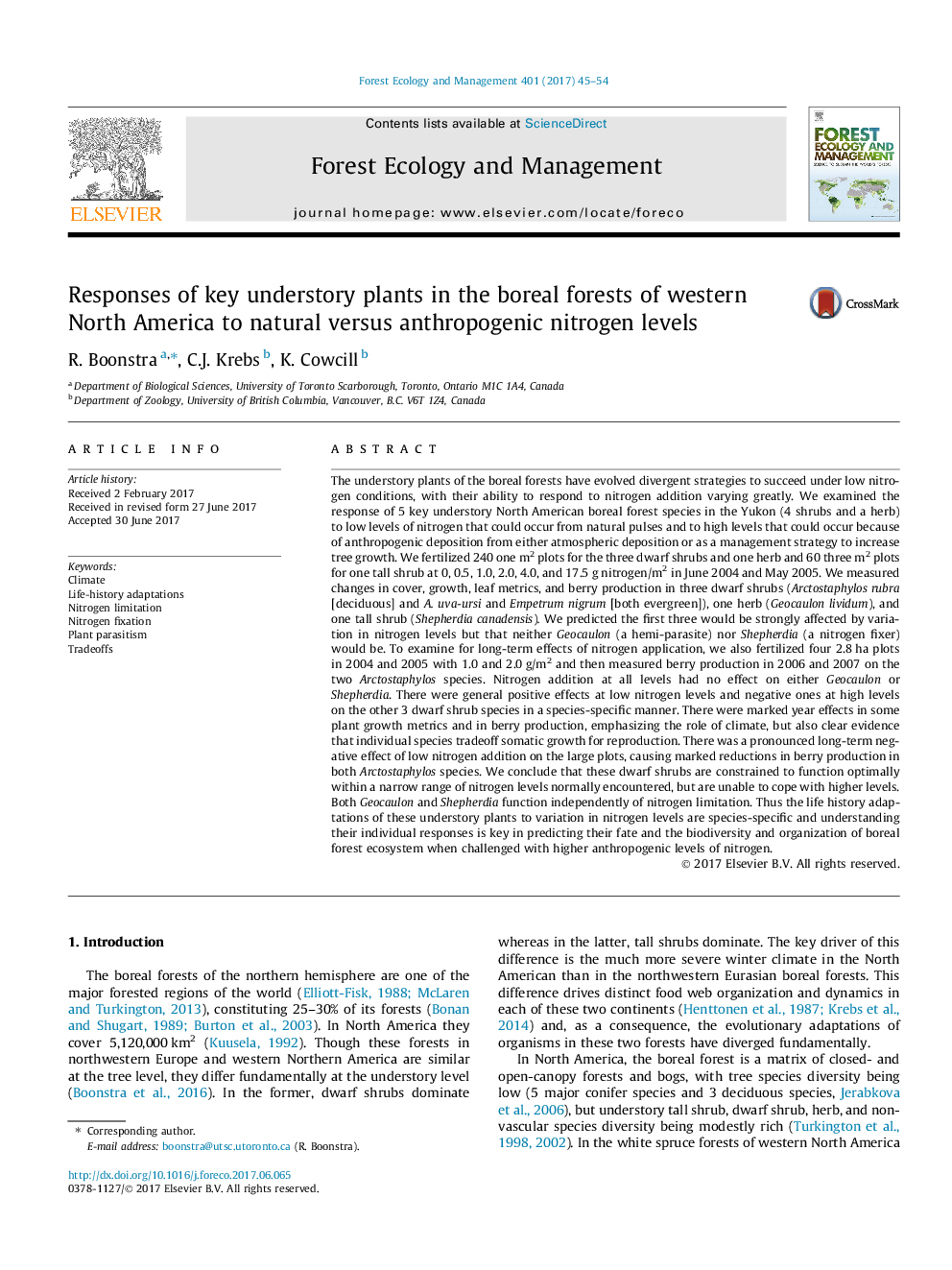| کد مقاله | کد نشریه | سال انتشار | مقاله انگلیسی | نسخه تمام متن |
|---|---|---|---|---|
| 4759299 | 1421357 | 2017 | 10 صفحه PDF | دانلود رایگان |
عنوان انگلیسی مقاله ISI
Responses of key understory plants in the boreal forests of western North America to natural versus anthropogenic nitrogen levels
ترجمه فارسی عنوان
پاسخ گیاهان کلیدی زیرزمینی در جنگلهای ساحلی شمال غربی آمریکای شمالی به سطوح نیتروژن طبیعی و انسانی
دانلود مقاله + سفارش ترجمه
دانلود مقاله ISI انگلیسی
رایگان برای ایرانیان
کلمات کلیدی
آب و هوا، سازگاری با تاریخ زندگی، محدودیت نیتروژن، تثبیت نیتروژن، انگل گیاهی تجارت
موضوعات مرتبط
علوم زیستی و بیوفناوری
علوم کشاورزی و بیولوژیک
بوم شناسی، تکامل، رفتار و سامانه شناسی
چکیده انگلیسی
The understory plants of the boreal forests have evolved divergent strategies to succeed under low nitrogen conditions, with their ability to respond to nitrogen addition varying greatly. We examined the response of 5 key understory North American boreal forest species in the Yukon (4 shrubs and a herb) to low levels of nitrogen that could occur from natural pulses and to high levels that could occur because of anthropogenic deposition from either atmospheric deposition or as a management strategy to increase tree growth. We fertilized 240 one m2 plots for the three dwarf shrubs and one herb and 60 three m2 plots for one tall shrub at 0, 0.5, 1.0, 2.0, 4.0, and 17.5 g nitrogen/m2 in June 2004 and May 2005. We measured changes in cover, growth, leaf metrics, and berry production in three dwarf shrubs (Arctostaphylos rubra [deciduous] and A. uva-ursi and Empetrum nigrum [both evergreen]), one herb (Geocaulon lividum), and one tall shrub (Shepherdia canadensis). We predicted the first three would be strongly affected by variation in nitrogen levels but that neither Geocaulon (a hemi-parasite) nor Shepherdia (a nitrogen fixer) would be. To examine for long-term effects of nitrogen application, we also fertilized four 2.8 ha plots in 2004 and 2005 with 1.0 and 2.0 g/m2 and then measured berry production in 2006 and 2007 on the two Arctostaphylos species. Nitrogen addition at all levels had no effect on either Geocaulon or Shepherdia. There were general positive effects at low nitrogen levels and negative ones at high levels on the other 3 dwarf shrub species in a species-specific manner. There were marked year effects in some plant growth metrics and in berry production, emphasizing the role of climate, but also clear evidence that individual species tradeoff somatic growth for reproduction. There was a pronounced long-term negative effect of low nitrogen addition on the large plots, causing marked reductions in berry production in both Arctostaphylos species. We conclude that these dwarf shrubs are constrained to function optimally within a narrow range of nitrogen levels normally encountered, but are unable to cope with higher levels. Both Geocaulon and Shepherdia function independently of nitrogen limitation. Thus the life history adaptations of these understory plants to variation in nitrogen levels are species-specific and understanding their individual responses is key in predicting their fate and the biodiversity and organization of boreal forest ecosystem when challenged with higher anthropogenic levels of nitrogen.
ناشر
Database: Elsevier - ScienceDirect (ساینس دایرکت)
Journal: Forest Ecology and Management - Volume 401, 1 October 2017, Pages 45-54
Journal: Forest Ecology and Management - Volume 401, 1 October 2017, Pages 45-54
نویسندگان
R. Boonstra, C.J. Krebs, K. Cowcill,
